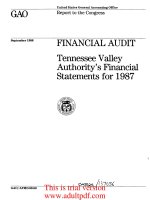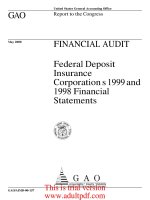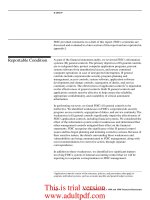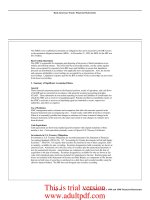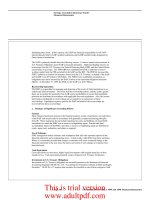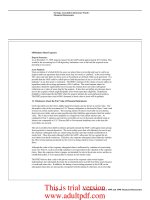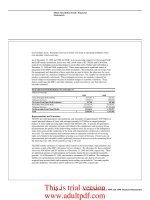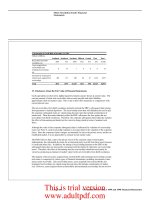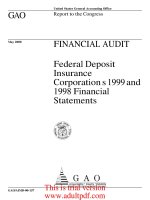United States General Accounting Office GAO May 2000 Report to the Congress FINANCIAL AUDIT_part8 docx
Bạn đang xem bản rút gọn của tài liệu. Xem và tải ngay bản đầy đủ của tài liệu tại đây (66.21 KB, 6 trang )
FSLIC Resolution Fund’s Financial
Statements
Page 69 GAO/AIMD-00-157 FDIC’s 1999 and 1998 Financial Statements
Concentration of Credit Risk at December 31, 1999
Dollars in Millions
Southeast Southwest Northeast Midwest Central West Total
Receivables from thrift
resolutions, net
$184 $33 $876 $151 $31 $91 $1,366
Assets acquired from
assisted thrifts and
terminated receiverships,
net
033 100034
Investment in securitization
related assets acquired from
receiverships
489 313 288 80 67 1,438 2,675
Total
$673 $379 $1,165 $231 $98 $1,529 $4,075
15. Disclosures About the Fair Value of Financial Instruments
Cash equivalents are short-term, highly liquid investments and are shown at current value. The
carrying amount of short-term receivables and accounts payable and other liabilities
approximates their fair market value. This is due to their short maturities or comparisons with
current interest rates.
The net receivables from thrift resolutions primarily include the FRF’s subrogated claim arising
from payments to insured depositors. The receivership assets that will ultimately be used to pay
the corporate subrogated claim are valued using discount rates that include consideration of
market risk. These discounts ultimately affect the FRF’s allowance for loss against the net
receivables from thrift resolutions. Therefore, the corporate subrogated claim indirectly includes
the effect of discounting and should not be viewed as being stated in terms of nominal cash
flows.
Although the value of the corporate subrogated claim is influenced by valuation of receivership
assets (see Note 3), such receivership valuation is not equivalent to the valuation of the corporate
claim. Since the corporate claim is unique, not intended for sale to the private sector, and has no
established market, it is not practicable to estimate its fair market value.
The FDIC believes that a sale to the private sector of the corporate claim would require
indeterminate, but substantial discounts for an interested party to profit from these assets because
of credit and other risks. In addition, the timing of receivership payments to the FRF on the
subrogated claim does not necessarily correspond with the timing of collections on receivership
assets. Therefore, the effect of discounting used by receiverships should not necessarily be
viewed as producing an estimate of market value for the net receivables from thrift resolutions.
The majority of the net assets acquired from assisted thrifts and terminated receiverships (except
real estate) is comprised of various types of financial instruments, including investments, loans,
and accounts receivable. Like receivership assets, assets acquired from assisted thrifts and
terminated receiverships are valued using discount rates that include consideration of market
risk. However, assets acquired from assisted thrifts and terminated receiverships do not involve
This is trial version
www.adultpdf.com
FSLIC Resolution Fund’s Financial
Statements
Page 70 GAO/AIMD-00-157 FDIC’s 1999 and 1998 Financial Statements
the unique aspects of the corporate subrogated claim, and therefore the discounting can be
viewed as producing a reasonable estimate of fair market value.
The investment in securitization related assets acquired from receiverships is adjusted to fair
value at each reporting date using a valuation model that estimates the present value of estimated
expected future cash flows discounted for the various risks involved, including both market and
credit risks, as well as other attributes of the underlying assets (see Note 4).
16. Supplementary Information Relating to the Statements of Cash Flows
Reconciliation of Net Income to Net CashProvidedby Operating Activities for the Years Ended December 31
Dollars in Thousands
1999 1998
Net Income $ 407,407 $ 1,657,793
Adjustments to Reconcile Net Income to Net Cash Provided by Operating Activities
Income Statement Items:
Interest on Federal Financing Bank borrowings 0 18,068
Provision for losses (278,267) (1,176,165)
Gain onconversion of benefit plan 0 (39,297)
Prior year appropriation adjustments 4,531 0
Change inAssets and Liabilities:
Decrease in receivables from thrift resolutions 437,750 2,307,756
Increase in securitization related assets acquired from receiverships (21,365) (1,415,155)
Decrease in assets acquired from assisted thrifts and terminated receiverships 13,788 61,928
Decrease (Increase) in other assets 35,680 (389,691)
Increase (Decrease) in accounts payable and other liabilities 34,710 (125,545)
(Decrease) in accrued interest on notes payable 0 (28,950)
(Decrease) Increase in liabilities fromthrift resolutions 92,414 130,794
Increase incontingent liabilities for litigation losses 3,968 13,897
(Decrease) incontingent liabilities for assistanceagreements 0 (1,476)
Net Cash Provided by Operating Activities $ 730,616 $ 1,013,957
Noncash Investing Activity
The FRF acquired securitization residual certificates through a noncash purchase from its
receiverships. This noncash transaction valued at $1.4 billion was applied to amounts owed by
FRF receiverships which resulted in a reduction to the “Receivables from thrift resolutions, net”
line item and an increase in the “Investment in securitization related assets acquired from
receiverships" line item (see Note 4).
17. Year 2000 Issues
State of Readiness
The FDIC, as administrator for the FRF, conducted a corporate-wide effort to ensure that all
FDIC information systems were Year 2000 compliant. This meant that systems must accurately
process date and time data in calculations, comparisons, and sequences after December 31, 1999,
This is trial version
www.adultpdf.com
FSLIC Resolution Fund’s Financial
Statements
Page 71 GAO/AIMD-00-157 FDIC’s 1999 and 1998 Financial Statements
and be able to correctly deal with leap-year calculations in 2000. An oversight committee
comprised of FDIC division management directed the Year 2000 effort.
The FDIC’s Division of Information Resources Management (DIRM) led the Year 2000 effort,
under the direction of the oversight committee. The internal Year 2000 team used a structured
approach and rigorous program management as described in the U.S. General Accounting
Office’s (GAO) Year 2000 Computing Crisis: An Assessment Guide. This methodology
consisted of five phases under the overall umbrellas of Program and Project Management. The
FDIC completed all of the recommended GAO phases: Awareness, Assessment, Renovation,
Validation, and Implementation.
As a precautionary measure, the FDIC developed a Year 2000 Rollover Weekend Strategy to
monitor the information systems during the transition into the year 2000. Contingency plans
were in place for mission-critical application failures and for other systems. No major problems
were anticipated due to the extensive planning and validation that occurred (see Note 18).
Year 2000 Estimated Costs
Year 2000 compliance expenses for the FRF are estimated at $1.3 million and $2.1 million at
December 31, 1999 and 1998, respectively. These expenses are reflected in the “Operating
expenses” line of the FRF’s Statements of Income and Accumulated Deficit.
18. Subsequent Events
Year 2000 Effect on Internal Systems
On January 1, 2000, all FDIC systems were operating normally as a result of a corporate-wide
effort to ensure that all FDIC information systems were Year 2000 compliant prior to December
31, 1999. No internal system failures have occurred and none are anticipated (see Note 17).
This is trial version
www.adultpdf.com
Ordering Information
The first copy of each GAO report is free. Additional copies of
reports are $2 each. A check or money order should be made out to
the Superintendent of Documents. VISA and MasterCard credit
cards are accepted, also.
Orders for 100 or more copies to be mailed to a single address are
discounted 25 percent.
Orders by mail:
U.S. General Accounting Office
P.O. Box 37050
Washington, DC 20013
Orders by visiting
:
Room 1100
700 4th St. NW (corner of 4th and G Sts. NW)
U.S. General Accounting Office
Washington, DC
Orders by phone:
(202) 512-6000
fax: (202) 512-6061
TDD (202) 512-2537
Each day, GAO issues a list of newly available reports and
testimony. To receive facsimile copies of the daily list or any list
from the past 30 days, please call (202) 512-6000 using a touchtone
phone. A recorded menu will provide information on how to obtain
these lists.
Orders by Internet:
For information on how to access GAO reports on the Internet,
send an e-mail message with “info” in the body to:
or visit GAO’s World Wide Web home page at:
To Report Fraud,
Waste, or Abuse in
Federal Programs
Contact one:
• Web site: />• e-mail:
• 1-800-424-5454 (automated answering system)
This is trial version
www.adultpdf.com
This is trial version
www.adultpdf.com
United States
General Accounting Office
Washington, D.C. 20548-0001
Official Business
Penalty for Private Use $300
Address Correction Requested
Bulk Rate
Postage & Fees Paid
GAO
Permit No. GI00
This is trial version
www.adultpdf.com
